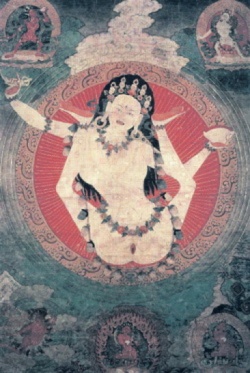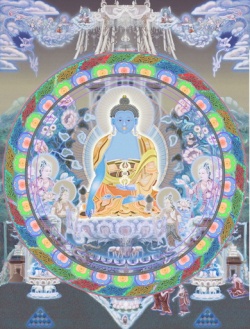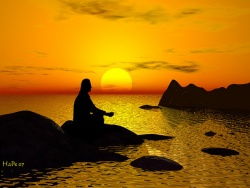Shambhala the Path of the Warrior by William A. Gordon
Speaking of warriorship in the context of the search for inner and outer peace might seem at first glance to be contradictory. The warrior in history is usually associated with unchecked aggression, with hostile Indian tribes in our early history, or with the violent assaults of nomads who roamed across Europe and Asia in ancient times destroying whole cities and villages. On the other hand, the warrior of Shambhala, as described originally by Chogyam Trungpa, combines fearlessness and gentleness. The warrior is not, therefore, addicted to naked aggression as the way of accomplishing his individual and selfish will, or, for that matter, the will of his or her state or nation. For the warrior, fearlessness is the source of strength and though it is mythically identified with masculine energies, it is not the exclusive property of men.
Gentleness, which is mythically the feminine side, is related to heart, with openness to others, with sympathy, compassion, and understanding. When people arrive at a Shambhala Center to begin to learn meditation and to incorporate the attitudes it brings into their lives, the reaction to “warriorship” is at first ambiguous. Somehow the meditative path seems to evoke quietness, suspension of action, letting go. How is that connected with being a warrior? How especially is it connected with the history of the term warrior and its identification with war and violence?
The Shambhala view of warriorship shares some of the qualities of earlier warrior traditions such as those from the Middle Ages that combined fearlessness with dignity and wisdom. The most important quality of the Shambhala warrior is being non-aggressive. The Shambhala warrior is defined by gentleness and fearlessness. As Chogyam Trungpa said it, “the first principle of warriorship is not being afraid of who you are.” That simple statement, however, contains a world of further investigation, searching, discipline, and openness to what we have become in this world and how we react to situations and people. The ultimate goal of the Shambhala path is to create an enlightened society of wise and compassionate human beings, which is the tradition of the Kingdom of Shambhala,
Shambhala, in other words, is very ancient. Its origins have been lost in time. Chogyam Trungpa, while he was in Tibet, had a vision of the possibility of bringing the insights of the meditative path into how we could create a sane compassionate society. When forced to leave after the Chinese Communist invasion of that country, he wrote an early version of the Shambhala view while hiding from the Chinese military in a cave. But when he was forced to cross a river with the Chinese shooting at him and his party, the manuscript was lost. It was not until years later, after reaching India and finally coming to the United States that the vision was given to him once more and he began to dictate the material we now have as the teachings of the path of the warrior.
The Teachings of Shambhala - Basic Goodness
Shambhala Training begins with the notion of basic goodness. The essence of basic goodness is the recognition that ordinary sense consciousness, looking, touching, tasting, smelling, hearing, has in it, no matter what the circumstances, a core of primordial energy which is beyond good and bad. This energy is said to be "unconditional," "unoriginated," and indestructible." To appreciate this teaching, one has to realize how much Western thinking, despite its rationalism, is dominated by the notion of "original sin." Not only does this Western tradition instill in us the feeling of innate evil in human affairs, but it separates us from the universe as sacred in itself. In fact, to show just how concrete such a difference can be, a Japanese economist recently attributed the problem with "quality control" in America to the "belief in original sin." Shambhala begins very differently, with an emphasis on “basic goodness.”
The first step for a spiritual search is to examine our own habitual minds. Meditation practice is like a box of tools for examining what and who we are, what the world is, and what our connection is with that world.. We begin to understand by means of meditation technique that the object world is not the source of the problem, rather that it is how we relate to that world that causes pain. If at this point we start actually walking the path of Shambhala meditation, we are given a very large generalization to help us understand ourselves and the world. We are told that the world and ourselves are basically good, that we already have everything we need, and that realizing the basic goodness in our own lives can revolutionize how we experience self and world. Basic goodness become a kind of background, or perhaps we should say the sky in which we work with the details of everyday world.
As we practice meditation over time, we may find we can go further and begin to understand and then let go of the various reference points that we have internalized during the process of growing up. We can see through all those concepts that defined how things were related to each other and to us. These reference points were not, for the most part, wrong, but they become so solid we can’t see beyond them. We need to learn how to connect with our human world in ways beyond our interactions with a mere collection of objects. Trying to accomplish that task with our conceptual, analytical mind too limited and narrow. Conceptual mind actually makes everything more solid. Somehow we have to go beyond that ordinary practical understanding to a deeper realization. So, as a first step, we should look more carefully at basic goodness.
Waking up, through the practice of meditation, allows us to distance ourselves from our personal clinging to outcomes, and to see the whole situation, as it were, from a birdseye view. We can recognize the energy of anger as a way of connecting with something very positive in our experience. By not projecting emotions, we can see how they originate, what nourishes them, how to go beyond them. So, as I say, emotions are energy, and there is nothing wrong with them. However, they are often connected to old systems, so that their main engine is fear. By going within our frozen attitudes, by melting them in our meditation practice, we find unlimited goodness within the energy of joy or anger, passion or fear, peace or anxiety. These frozen attitudes have a name in Shambhala. We call them "cocoon."
Cocoon is the protection we have built for ourselves of our view of self and of the world. Many aspects of cocoon begin when we are very young, so the roots of our different protective strategies are not immediately visible to inspection. We want the world to exist in ways that confirm our preconceptions. It was said by one psychologist that we continue to look constantly for information that “matches our perceptions.” Each of us, thus, sees a different world. That world exists in our minds as various systems of belief. The way to cut through cocoon is to use the tools of meditation to first quiet the mind and secondly, to see into the patterns of cocoon.
The practice of meditation is characteristic of teachings from the East that they are offered personally and orally, rather than through abstract theory given in books. Thus the Shambhala teachings are ordinarily presented in a series of sequential weekends where we interact directly with the teachers. In effect, weekends combine theory and practice.. So, as we wind our way slowly through the weekends, we begin to take meditation practice seriously. There is a point, in fact, when we cannot go back to where we were. When we let our practice go for some weeks or months, we find that we miss it. Something is going on! We begin to discover, as we continue to meditate, that our mind is actually slowing down, even after meditation has ended. Instead of getting caught in every little trivial thought, we can see the thought arise and decide whether to follow it further or not.
Much of what happens to us will still resembles the old mind and memory that we originally brought with us to meditation. Still, we see enough evidence of change, even after a few months, that we are encouraged to continue. It would be nice to discover that everything mellows out, gets more peaceful, but that isn't the way it works. We actually begin to be more sensitive to our own contradictions. We begin to get glimpses of how we relate to our spouse, our children, our parents, our work. We begin to discover hidden hopes and fears that we didn't even know were motivating us. Sometimes we feel disgusted with ourselves. So, in some ways, the split between the restfulness of practice and the agitation of discovery is very painful, but we also begin to realize that we are on a very meaningful journey, perhaps the most important of our life.
The second stage of meditation is often described as the stage of "insight." This usually develops quite naturally, but it is a stage that can be quite vexing. As long as we have the simple task of following our breath, all seems very straightforward. But we are also charged with "getting to know our minds," this without analysis or following thoughts to their logical conclusion or trying to find out where they came from. We are told that we can develop a non-judgmental awareness about what is happening, without trying to decide whether it is good or bad.
At first this seems to be rather abstract. "Whatever are they talking about?" we may ask. But then, in the midst of the usual trivial buzz of thoughts and feelings, we seem to enter a space where everything is present simultaneously. We see not only this thought and that thought, this feeling and that feeling, but contradictory thoughts and feelings, seemingly all at once. Furthermore, we find that we do not have to identify ourselves with these concepts and emotions. Thoughts, as it were, come and go; they elevate emotions, they depress them, but awareness is there no matter what the thoughts are doing. Things begin to slow down; we find that we can pay attention simply to the events of our daily life. Finally, we can realize that the "me" that was so involved in all these projects is itself somewhat questionable. This is the beginning of the discovery of egolessness.
Egolessness is the method that allows us to slowly see into the cocoon and ultimately to dismantle the patterns that hold us to particular reference points in our view of reality and of the self. Mindfulness/awareness meditation is a very ancient technique, older it is said than Buddhism. In any event, it has been tried and proved in action by thousands of practitioners over many centuries. The technique itself is deceptively simple. We sit quietly, usually on a cushion, and focus our attention on some object. It could be anything, a rock for example, but in this tradition we usually focus on the act of breathing. We follow the inbreath as it goes in and the outbreath as it goes out. Very simple! When we get distracted by fantasies, feelings, or thoughts, and wake up to the fact that we are no longer paying attention to our breath, we simple note what the distraction was and then come back to the breath. It is important in this technique that we not regard distractions as “bad.” Rather, they are treated as irrelevant, simply as momentary events arising out of basic mind.
This is boring work; as Chogyam Trungpa said, it is like having only one teddy bear which we explore thoroughly. For a long time we do it more out of faith or trust in the teachings than out of any sense of accomplishment. But faith and trust in who or what? Not religious faith in this case, but faith in our own basic goodness balanced with some confidence in the teachings and teacher. The first level of faith is that we begin to find fairly soon, even on the first weekend that something is going on, something that we get very interested in. Moreover, the teachings themselves make sense to us and those who are teaching us, as we get to know them, seem to have learned something.
Awakened Heart
The scientific rational tradition has tended to reduce the world, including the body, to a mechanism. Our thoughts and feelings go on inside, and they tell us about the real existing world “out there.” Only the head, the brain, in our modern world seems real and alive; only conceptual thought knows reality. And reality is conceived as objective, separate from the self and the source of all valid knowledge. Our subjective selves, as hundreds of psychologists tell us, are really impoverished. In consequence, we suffer from deficits in feeling, a sense of isolation, alienation. Inner conflict often turns into serious illness - into all the diseases that are peculiar to modern industrial civilizations.
At the same time, on the cultural level, separate, physical things, whether food, sex, or simply air, soil, and water, were gradually depreciated. Abstract truths of politics, religion, and more recently economics seemed more true than our concrete everyday experience. In consequence, we find ourselves divided into thousands of separate worlds by ideas which we hold with a murderous fury toward those who disagree. As humans in the modern world, we have forgotten the more basic reality, that we are connected to each other and the world at a very deep level, in what Fritjov Capra has called “The Web of Life.” When we are separated by abstractions - which includes a “consumerism” in which quantity replaces quality - we lose the possibility of living with each other in a fully human world.
The knowledge of the heart, by contrast, is direct and concrete rather than abstract. When we realize that our attitudes to self and other are constructions of mind, we can begin to appreciate relationship as more real than separation. One very important aspect of that knowing is intuitive insight into our connection with others. This insight is the ground of compassion. Compassion is knowledge beyond and before abstractions or universals. The key to understanding compassion, as the Dalai Lama has said, is to realize that it is our basic nature, not something added to our repertoire like learning to dance.
We attain insight into compassion by working our way back through our cultural and personal conceptual constructs. By clearing away the false conceptions that separate us from the world, we are actually able to realize that our welfare and that of our neighbor or that of the world itself are inseparable. Thus, f rom heart-knowledge arises true compassion. Charity and compassion in our culture are often institutionalized rather than individual and then they are subordinated to economic systems. That is why our culture can be so contradictory, taking away with one hand what it apparently gives with the other. We encourage private charities but, if they don’t solve the problems, we oblige government to pretend nothing is wrong.
True compassion is not something acquired, it arises from the unfolding of wisdom. Wisdom sees that “self” is not solid but more like a collection of views, a micro-self looking at a micro-world. We support our feelings of a central self by clinging to various aspects of the world that are familiar. De-centering from our own obsessive preoccupations with our selves leads to an intuitive and direct sense of our connections with others. We can then realize directly that we construct the world in which we live together with others. We exist interdependently with those others. Without others, we cannot experience a self. [Francisco Varela et al, Embodied Mind)
The first step, then, in connecting our hearts with our experience is to reduce the domination of our fixed agendas, our ready abstractions which we project onto situations and people. We can be inquisitive about the world without trying constantly to make that curiosity serve a purpose. Then we open ourselves to the world with all of our rawness and tenderness. This means especially opening up to perception, to our ongoing connection with the world of our direct experience. An important part of that connection is our relation to other people, not only those close, but all humans everywhere. It is a natural kind of human knowledge that our materialistic culture has seriously damaged. To economic man, according to economic doctrine, helping others is simply another kind of “utility,” a gain in pleasure for the self.
Without this inner understanding, we find in everything we see our projections. Our ideas of cars, food, houses, dolphins, acid rain, liberals and conservatives are about "me" not about "them." There is nothing wrong with interpretation in itself, but we must be able to go back to the raw experience. Direct perception is the basis for Awakened Heart, which also includes our sense of connection with the universe and each other.
Awakened heart, in this sense, can also be called "non-goal oriented questioning." Instead of constantly demanding specific answers in situations, we can just be open to all of the possibilities. As we are active in the everyday world around us, we see that interpretations arise quite naturally, that is how mind works, but by staying in touch with awareness, we can come back over and over to simple perceptions. From basic perceptions, we see how things in the world work, how situations and people are connected. This is wisdom. Seeing connections, we discover compassion or sad and tender heart. From wisdom and compassion arise skillful means, knowing what to do and how to do it. Thus we create an enlightened society.




